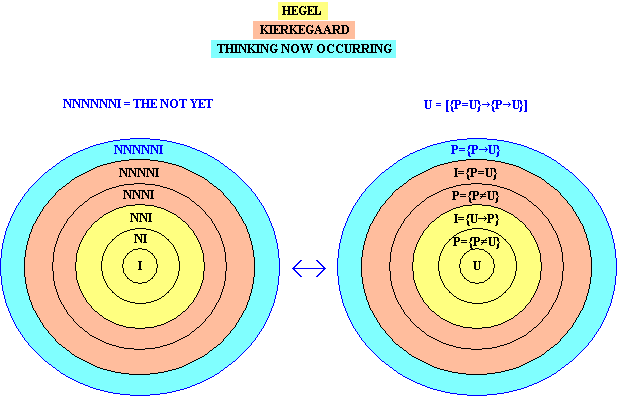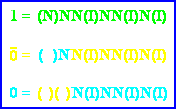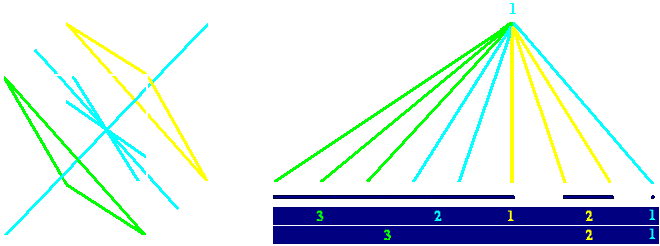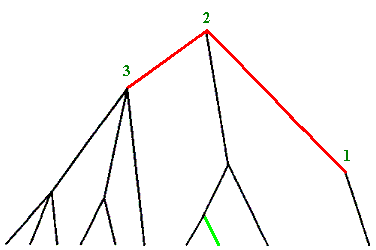
NOTE TO FAITH AND PHILOSOPHY
FURTHER TO THE ONTOLOGY
OF REAL TRINARY LOGIC

In the above Index of Logico-Existential Relations existing between Hegel's dialectic of absolute reason (coded in Yellow), Kierkegaard's transcription of faith as the absolutely absurd beyond reason on the edge of existence (coded in Ruddy Sand) (cf. D.G. Leahy, Faith and Philosophy: The Historical Impact [Aldershot, 2003], Chapters 4-5, et passim), and the thinking now occurring for the first as the creation of the absolute edge/existence (coded in Blue Green), N negates what lies to its right, I (in the left set of circles) = Infinite, U = Universal, P = Particular, and I (in the right set of circles) = Individual.
In the New York Philosophy Corporation Fall 2004 course Introduction to Faith and Philosophy the following was posted to the Question & Answer Forum by Zarina Maiwandi on October 26: "How is the not yet NNNNNNI a negation of the thinking now occurring for the first time NNNNNI? Analogously, how is the identity of particular and universal {P=U} creating the absolute now {P→U} as universal a move 'beyond' the outer ring of the thinking now occurring for the first time?"
The
instructor's answer: The first and most fundamental thing to notice on the
Index of Logico-Existential relations is that only in the case of Hegel is there a consistency of color
throughout the three rings (Yellow). If Kierkegaard’s
absurd transcendence of Hegel involves his taking the latter’s endpoint (Hegel’s
third ring [Yellow]) as his starting point, nevertheless,
immediately Kierkegaard’s second and third rings are of a different color (Ruddy
Sand), this different color indicating his essentially ecstatic position vis-à-vis
absolute self-consciousness. Kierkegaard’s second ring/moment of particularity P
= {P≠U} repeats Hegel’s second ring/moment of particularity P = {P≠U}, but, as
indicated by the color change from Yellow to Ruddy Sand, now outside the
self-enclosedness of the Absolute Idea, so that his conclusion/conexio, his
third ring, wears the color of his pivotal second ring (the moment of
sin-consciousness). The formal identity of content shared with Hegel when it
comes to second rings P = {P≠U} indicates Kierkegaard’s continuing tie to
self-consciousness and the latter’s conception of negation as related to
‘nothing’ and of double negation as a form of reaffirmation or restoration. Now
notice that what in the thinking now occurring is effectively in the place of
the preceding second rings—indeed, the thinking now occurring itself—is no
longer a ‘moment’ to be ‘sublated’ by a third ring since what would be a third
ring—the not yet NNNNNNI = U = [{P=U}→{P→U}]—is not a third ring outside/beyond
the second ring P = {P→U} whose relation to its second and first rings is
respectively a relation to nothing (vis-à-vis the second) or a self-reaffirming
or self-restoring relation of double negation (vis-à-vis the first), but rather
that of the Unity of real trinary logic 1 (not not not nothing [Faith and
Philosophy, pp. 116f.]) that is the completely differentiating Unity of ![]() (not
not nothing) and 0 (not nothing) (cf. D.G. Leahy, Foundation: Matter the Body
Itself [Albany, 1996], Section III.1). NNNNNNI corresponds to the Unity (1) of real
trinary logic as N(NNI) (= 1) in its relation to N(NI) (=
(not
not nothing) and 0 (not nothing) (cf. D.G. Leahy, Foundation: Matter the Body
Itself [Albany, 1996], Section III.1). NNNNNNI corresponds to the Unity (1) of real
trinary logic as N(NNI) (= 1) in its relation to N(NI) (= ![]() )
and (NI) (= 0), where (NI) is the Kierkegaardian impolite/absurd assertion of
the Cartesian not nothing (Faith and Philosophy, Chapters 2-4, et passim) outside the bounds of absolute reason, the
Kierkegaardian moment of salvation (the equality of the God with the learner) I
= {P=U}. Kierkegaard’s endpoint (his third ring [Ruddy Sand]) is now the starting
point of the thinking now occurring whose endpoint NNNNNNI = U = [{P=U}→{P→U}])
is precisely not a form of self-conscious negation or self-conscious double
negation but rather is the perfect liberating-comprising in which the act of
absolutely particular other creation now actually occurring for the first time
{= the thinking now occurring epitomized as
)
and (NI) (= 0), where (NI) is the Kierkegaardian impolite/absurd assertion of
the Cartesian not nothing (Faith and Philosophy, Chapters 2-4, et passim) outside the bounds of absolute reason, the
Kierkegaardian moment of salvation (the equality of the God with the learner) I
= {P=U}. Kierkegaard’s endpoint (his third ring [Ruddy Sand]) is now the starting
point of the thinking now occurring whose endpoint NNNNNNI = U = [{P=U}→{P→U}])
is precisely not a form of self-conscious negation or self-conscious double
negation but rather is the perfect liberating-comprising in which the act of
absolutely particular other creation now actually occurring for the first time
{= the thinking now occurring epitomized as ![]() =
( )NN(I) [=
=
( )NN(I) [= ![]() ],
NN(I) [=
],
NN(I) [= ![]() ],
N(I) [= 0] [Kierkegaard’s second ring wearing a new color (Blue Green)]} is the
consequence of the saving equality established by the God epitomized as 0 = ( )(
)N(I) [= 0], NN(I) [=
],
N(I) [= 0] [Kierkegaard’s second ring wearing a new color (Blue Green)]} is the
consequence of the saving equality established by the God epitomized as 0 = ( )(
)N(I) [= 0], NN(I) [= ![]() ],
N(I) [= 0]. Finally, note that the thinking now occurring for the first time qua
second ring/ring of the particular has a content completely different from that
shared by the second rings/moments of Hegel and Kierkegaard, viz., P = {P→U}. It
is precisely this reversal of Hegel’s third ring/I-moment predicated of absolute
P = {P→U} (= Absolute Particular the Particular creating the Universe) that is the pivotal
beginning of the Resurrection and precisely that which is not found in
Kierkegaard due to his absolute negation of reason.
],
N(I) [= 0]. Finally, note that the thinking now occurring for the first time qua
second ring/ring of the particular has a content completely different from that
shared by the second rings/moments of Hegel and Kierkegaard, viz., P = {P→U}. It
is precisely this reversal of Hegel’s third ring/I-moment predicated of absolute
P = {P→U} (= Absolute Particular the Particular creating the Universe) that is the pivotal
beginning of the Resurrection and precisely that which is not found in
Kierkegaard due to his absolute negation of reason.
The following constellation of images illustrates the complex simplicity of the Unity of real trinary logic that preserves in a perfectly differentiated Unity the real differences in its constituents:


In the thinking now occurring for the first time the beginning otherwise than the beginning of being not otherwise than being (ibid., pp. 115ff. and 152ff.) is the beginning of being and nothing otherwise than otherwise than x, or, beyond beyond x (for beyond beyond x as existence for the first time beyond the Good, see, on this web, Beyond the Good: Not Hither the Good [& Not Hither Beyond the Good]; for beyond beyond x as beginning the infinite difference of x, see, on this web, The Real Beyond the Void: the Beginning/the Power Body; for beyond beyond x as mathematically instantiated in the absolute dead center cube, see, on this web, The Deep Epidermal Surface: The Cornerstone Construction Order, Minimum Order Tetrahedron Hypercube, & Absolute Dead Center Hypercube, also Theorem & Proof: The Uniqueness of the Absolute Dead Center Cube, and The Magnitude of Being). Where N, NN (x) = otherwise than x, i.e., not x [N(x)] and not not x [NN(x)], or, beyond x, and x = otherwise than x, or, beyond x, i.e., [(N[x]) (NN[x])], then the real trinary logic conception of existence absolutely differentiated for the first time is the beginning of absolute thisness, the beginning of the absolute here (and) now, or, NNNNNNI = THE NOT YET = BEYOND BEYOND X =
[N, NN (x)] = [N(N[x])], [N(NN[x])], [NN(N[x])], [NN(NN[x])]
where the number of N's preceding (x) within the brackets on the left side of the equation corresponds to the number of greens in the real trinary logic categorial array illustrated last above (reading indifferently right to left or left to right), and the number of N's preceding [x] within each parenthesis on the right side of the equation corresponds to the sequence of blues and yellows (reading left to right) marked here by the respective outer bracket colors: {3 (= 3 green)} + {1 (= 1 blue) + 2 (= 2 yellow) + 1 (= 1 yellow) + 2 (= 2 blue)}. Where p = identical number of N's inside and outside the parentheses (on the right side of the equation) and q = identical color of bracket and inside N's (on the right side of the equation) the reversal above in the trinary logic categorial array of the one blue, two yellow subsequence to the one yellow, two blue subsequence is the immediate (sensible) manifestation of the fact that the logical structure of NNNNNNI = THE NOT YET = BEYOND BEYOND X (reading right to left) conforms to the fundamental form of all logical statements in which the ordinary order of the third and fourth logical elements is likewise reversed (pq + pq + pq + pq) (cf. Leahy, Foundation, p. 258, n. 3). The visible reversal of the one blue, two yellow number-to-color ratio in the trinary logic array is sensibly the reversal of the relative positions of the uniformly positive and negative logical elements vis-à-vis the non-uniformly positive and negative elements and at once the reversal of the positive and negative order within the latter.
The ratio of the number of THE NOT YET N's to the number of N's associated with the elements of the real trinary logic array (N+N+N+N+N+N)/(NNN+N+NN+N+NN) is 2/3. The immediate simplicity of the perfectly differentiated Unity of real trinary logic, where, as here, an essentially relative or absolute Unity predicates 3 of 2 (cf. ibid., Section III.1, Afterword 2), contrasts with the imperfectly differentiated Unity of the real triadic duality of C.S. Peirce's logic of relatives as drawn by Peirce himself in The Categories Defended in C.S. Peirce, The Essential Peirce: Selected Philosophical Writings (Bloomington and Indianapolis, 1998), p. 162 [colors and category numbers added], where an inessentially relative Unity effectively predicates 3 of 1 (cf. Leahy, Foundation, Section III.1, Afterword 2),

and where Peirce's inessentially relative Thirdness can literally be seen to fall short of the perfect unification of the absolutes Firstness and Secondness. Here the essentially mediated existence of the categories = 9 + 1 = 10 the foundational 9 natural numbers plus the repetition of 1 displaced to the left by 0 that effectively extends the Unity of the foundational set of 9 beyond itself in an infinitely ascending repetition of the elements of existence.
Peirce's inessentially relative Thirdness contrasts with the absolutely mediated existence of the categories that is the identification of real trinary logic and existence whose elements = 9 (illustrated three and two paragraphs above) the foundational set of natural numbers. Note that the product of the natural numbers that are their integral products (1, 784, 82944; cf. Leahy, Foundation, Section III.6) involves precisely and exclusively this foundational 9-set of natural numbers:
![]()
(Further for the ninefold real trinary logic cornerstone, see, on this web, The Real Beyond the Void: the Beginning/the Power Body, et passim. Note that the integral product of the Hebrew for "absolute newness"/"absolute creation," חדוש גמור, is 82944 × 9. Its linear product is 8.2944 × 109, and its rational product 9 × 10-5. For ‘integral product’ etc., see, on this web, Transdecimal Calculation of Number Identity: A Note on Integral Product & Related Terms.)
Finally, in real trinary logic thought is predicated of existence for the first time so that here the elements of which 3 is predicated (see above) are at once the powers of 3. The Unity of real trinary logic is to the Unity of Peirce's real triadic duality as 32 is to 31 (where the former is existence absolutely and the latter is mediately related to existence), while the Unity that is the logic of Hegel's Absolute Idea where a formally relative Unity effectively predicates 3 of 0 is equivalently 30 = 1 (where "logic coincides with metaphysics the science of things set and held in thoughts" [G.W.F. Hegel, Encyclopaedia of the Philosophical Sciences, I.II.24]), as here illustrated (cf. Peirce's critique of the nominalism of Hegel's Absolute One, The Essential Peirce, pp. 164 and 177, et passim; also, Leahy, Faith and Philosophy, Chapter 7, et passim),
